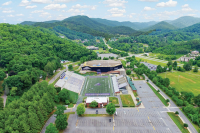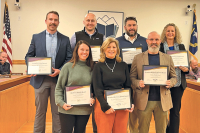Fast for cars or pleasing for people? Tug of war rages over 107
There’s a novel solution afoot for traffic woes on Sylva’s commercial thoroughfare: widen the road so much it obliterates most of the businesses.
“You certainly wouldn’t have a traffic problem on 107 if you took out 80 businesses,” said Sarah Graham, a community transportation planner with the Southwestern Development Commission.
Yet that’s the top option in a study of how to fix N.C. 107 recently completed by the N.C. Department of Transportation.
Of course, bulldozing businesses wasn’t the goal, but rather an accidental side-effect of all the lanes along with a 30-foot medians the DOT says will be needed one day to allay congestion.
The massive widening contained in the DOT’s study has been summarily rejected by elected leaders in Sylva, and at the county level.
“Nobody liked it,” Graham said.
Related Items
Joel Setzer, head of the DOT Division for the 10-western counties, can understand why. It’s not exactly the vision people in the community had in mind, Setzer said, citing comments he heard at a public input meeting during the feasibility study.
“Folks said they wanted to see 107 operate more as a Main Street commercial district and be improved within the existing footprint,” Setzer said.
But 107 also has to move a high volume of traffic.
“For it to be both will be a difficult thing to pull off,” Setzer said.
In hopes of finding a middle ground, Graham has applied for a grant to hire an independent consultant to do a new feasibility study. Graham believes a solution for 107 is within reach if the community thinks outside the box.
“We’ve all been to areas with roads similar to 107 but that function better, look nicer, are safer to drive on, but are equally as full of businesses,” Graham said.
It will take a whole bag of tricks to solve 107 traffic woes, she said, ticking off a list of catch phrases common in traffic planning circles: access management, traffic calming, intersection redesigns, turning nodes, rear-access drives and shared entrances.
“We might just need to look at it one block at a time and look at fixes that are real specific to each area and what it can handle,” Graham said.
Graham hopes a do-over of the DOT’s feasibility study will come up with such suggestions.
Setzer said these micro-fixes might work for a while, but would be temporary Band-Aids.
“We can do a little bit here and a little bit there,” Setzer said. But “after some time we are going to run out of tricks.”
Jason Kiminker, a Sylva businessman and advocate with the Smart Roads Alliance, disagreed.
“I think the correct solution is going to be surgery. A very precise surgery. Not a bomb that is dropped on the road,” Kiminker said.
Setzer countered that the feasibility study is far from a final road plan.
“If this project goes into design, we would be looking at finding ways to avoid these impacts,” Setzer said.
Setzer said there is wiggle room in the lane width and the width of the median, which is a whopping 30-feet in the feasibility study.
But the community also has to figure out how much congestion they are willing to tolerate.
“Is congestion out there today an acceptable level? Can we live with more or do we need less congestion?” Setzer said.
Kiminker questions the so-called congestion, and considers the future traffic estimates predicted by DOT a flawed premise.
“They can forecast whatever they want then say 107 won’t be able to carry it,” Kiminker said.
What about the bypass?
Percolating at the edge of the debate over 107 is the looming question of whether to build a new bypass around the commercial stretch. Once known as the Southern Loop and now deemed the 107 Connector, the bypass would plow virgin countryside to skirt the business district, giving through commuters a direct route to U.S. 23-74.
Opponents to the bypass clamored for the DOT to instead fix 107 traffic congestion without building a new road.
County commissioners and town board members also called for examining fixes to 107 first.
So the DOT sanctioned the feasibility study, and like Setzer predicted, it concluded 107 would have to be much, much wider to handle future traffic on its own, without the aid of a bypass.
“I intuitively knew it would be very disruptive but I wanted to have people take a professional look at it,” Setzer said. “Everybody said fix 107, but the devil is always in the details as to what it would take to fix 107.”
Graham said even with a bypass, however, future 107 traffic woes won’t be resolved.
“The studies show the connector will relieve some traffic on 107 but not enough to solve our problems,” Graham said.
Setzer agreed.
“I have been an advocate for both projects. Fixing 107 and also offering an alternative to 107,” Setzer said.
Kiminker fears the DOT is using fear mongering to steer the public toward supporting a bypass.
“They are showing you all the worst possible scenarios,” Kiminker said of the feasibility study.
Kiminker said there are “much more palatable, much less expensive and more low impact” options, but the DOT had an ulterior motive.
“The entire point of the study was not to see how 107 was improved, it was about showing that the connector was needed,” Kiminker said. “We haven’t been fooled — this feasibility study can be shelved in the garbage can where it deserves to go.”
Setzer said the public wanted a feasibility study, and that’s what they got. He can’t help the findings.
“We had input from the general public, we had input from advocacy groups and input from local government that said they would like us to look and see at fixing 107 before relieving congestion through other means,” Setzer said.
Setzer welcomes a second feasibility study by an independent firm should the grant come through, as well as the continued dialogue it is bound to bring about.
Of course, talk is cheap. The price tag for the full-blown widening outlined in the DOT’s feasibility study is $103 million. And it’s nowhere on the horizon, at least according to the DOT’s long-range road building list.
Nonetheless, it’s not a moment to soon to start crafting a design the community can get behind, Graham said.
“At least the town and county would be armed with a plan so as funds came available to do some road improvements they would have defined what their problems were and solutions were on more of a micro level,” Graham said.
If given a blank canvas, no road engineer today would build a road that looks or functions like 107. Constraints posed by commercial development flanking the corridor certainly makes it harder to fix, she said.
“So it is working backwards a little bit, but there is no time like the present. I don’t think it is hopeless,” Graham said.









